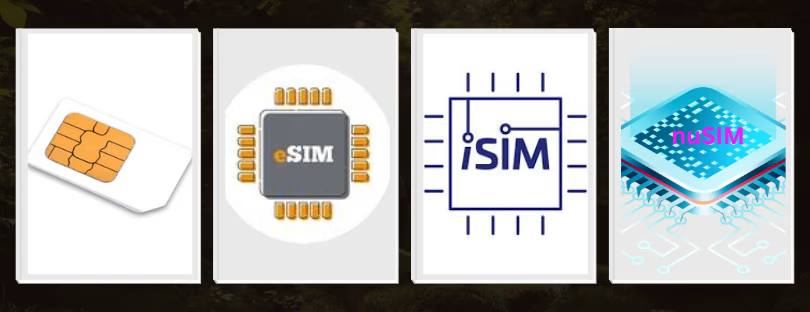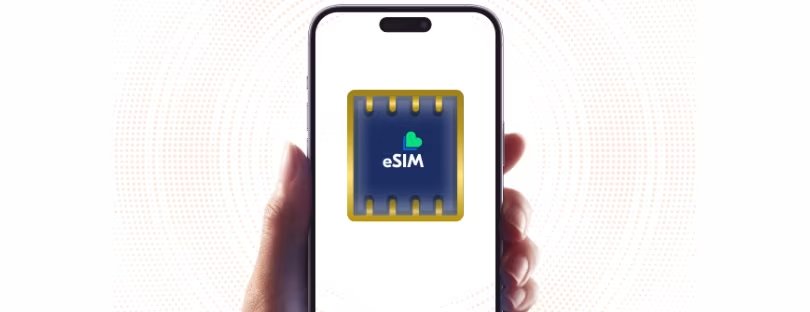
SIM, eSIM, iSIM, nuSIM: What’s the Difference… and Should You Care?
Let’s be honest—most of us don’t really think about SIM cards until we’re about to travel or our phone throws a “No SIM” error. It’s one of those tiny pieces of tech we all rely on but rarely talk about. But here’s the thing: the humble SIM card has come a long way—and it’s still evolving.
From the plastic SIM you can hold in your fingers, to chips soldered into your phone, to SIMs you can’t even see, there’s a whole journey happening here. Whether you’re a frequent traveler, a tech enthusiast, or just someone curious about how your phone connects to the world—this one’s for you.
So let’s unpack the whole SIM evolution: SIM card → eSIM → iSIM → nuSIM. What do they mean, and why do they matter? SIM vs eSIM vs iSIM vs nuSIM
First things first: What exactly is a SIM card?
SIM stands for Subscriber Identity Module. It’s that tiny chip you pop into your phone to connect to a mobile network. It holds your identity as a mobile subscriber—your phone number, authentication keys, network preferences, and sometimes even a little contact list if you’re old school.
Think of it as your phone’s passport to the mobile world.
These physical SIM cards come in several sizes—standard, micro, and nano—but they all do the same thing: let your device talk to your mobile carrier.
But let’s be real. Swapping SIM cards can be annoying. You need a pin tool. You drop the card. You insert it upside down. You curse under your breath. And if you’re traveling internationally? You’re juggling multiple cards and probably losing at least one.
That’s where eSIM comes in.
eSIM: Your SIM, but way smarter (and invisible)
eSIM stands for embedded SIM. It does everything a regular SIM does—but it’s built into your device. You don’t remove it. You don’t insert it. You don’t need a paperclip. You just scan a QR code or download a profile, and boom—you’re connected.
For travelers, this is a game-changer. Imagine landing in Tokyo, opening your eSIM app, buying a data plan for Japan, and connecting in under two minutes—no kiosks, no waiting, no swapping.
eSIMs also mean phones can be slimmer, more water-resistant, and way more flexible when it comes to switching carriers. In some countries (like the U.S. with the iPhone 14), phones are now only using eSIMs—no physical slot at all.
But just when you thought eSIM was the future, tech companies said, “Hold my coffee.”
iSIM: Integrated and invisible
Now we’re stepping into the truly futuristic stuff.
iSIM stands for Integrated SIM, and unlike eSIM—which is a separate chip soldered onto your phone’s motherboard—iSIM is integrated directly into your device’s main processor.
That’s right: no separate chip, no extra hardware, just a tiny section of your phone’s brain doing the job of a SIM.
Why does this matter?
Well, for starters, it saves even more space. Devices can be smaller, more efficient, and potentially cheaper to manufacture. It’s especially useful for IoT (Internet of Things) gadgets—like smartwatches, connected cars, and security devices—where space is at a premium.
And from a security standpoint, iSIMs could offer tighter integration and better protection. Plus, carriers can still manage your subscription remotely, just like with eSIM.
The downside? iSIM isn’t mainstream yet. Only a few devices have them, and most carriers are still playing catch-up.
nuSIM: The new kid with a specific purpose
Now here’s a name that might be totally new to you: nuSIM (pronounced “new SIM”).
This one’s designed specifically for IoT devices—but with a twist.
nuSIM is entirely software-based. That means there’s no physical SIM, and no embedded chip either. Everything lives in the device’s chipset, and it’s provisioned at the time of manufacture.
So what’s the point?
nuSIMs are made for ultra-simple, ultra-cheap, ultra-efficient devices—like smart meters, environmental sensors, or GPS trackers. These devices don’t need fancy features or even a ton of security—they just need to connect. And they need to do it cheaply, reliably, and without needing to install or swap a SIM.
By baking the SIM into the software early on, manufacturers save time, energy, and cost. It’s also easier to mass-produce and manage fleets of devices.
If you’re a traveler, nuSIM probably won’t affect your phone just yet—but in the connected world of smart homes, smart cities, and smart everything, it’s playing a growing role.
So… Which SIM is the “best”?
That depends on your situation.
- Standard SIM cards are still widely used and work just fine, especially in regions where carriers haven’t fully adopted eSIM yet.
- eSIMs are ideal for travelers, digital nomads, and anyone who likes the idea of managing their mobile plan digitally.
- iSIMs are the sleek, behind-the-scenes stars that could soon become the norm in smartphones and wearable tech.
- nuSIMs are the go-to for industrial and commercial IoT—think logistics, agriculture, energy monitoring—not your next smartphone.
In short, they all have a place.
Why this matters more than ever
Let’s zoom out a little.
We’re entering an era where connectivity is everything. Our homes, cars, watches, suitcases, and even pet collars are getting connected. The evolution of SIM technology isn’t just about making phones thinner—it’s about powering a world of devices that need to stay online, securely and efficiently.
For global travelers, these SIM advancements mean more freedom, fewer plastic cards, better deals, and instant connectivity. And for the tech world, they open up new doors for innovation.
Final thoughts SIM vs eSIM vs iSIM vs nuSIM
SIM tech might not be flashy, but it’s one of the most foundational parts of our connected lives. Whether you’re streaming Spotify on a train in Spain, checking your boarding pass in Bangkok, or tracking your luggage in real time—some form of SIM is behind the scenes making it all work.
And that tiny card you used to fumble with? It’s now evolving into invisible software that’s smarter, faster, and ready for the future.
So next time your phone says “No SIM,” just remember—you’re living through one of the coolest tech transitions that most people never notice.









